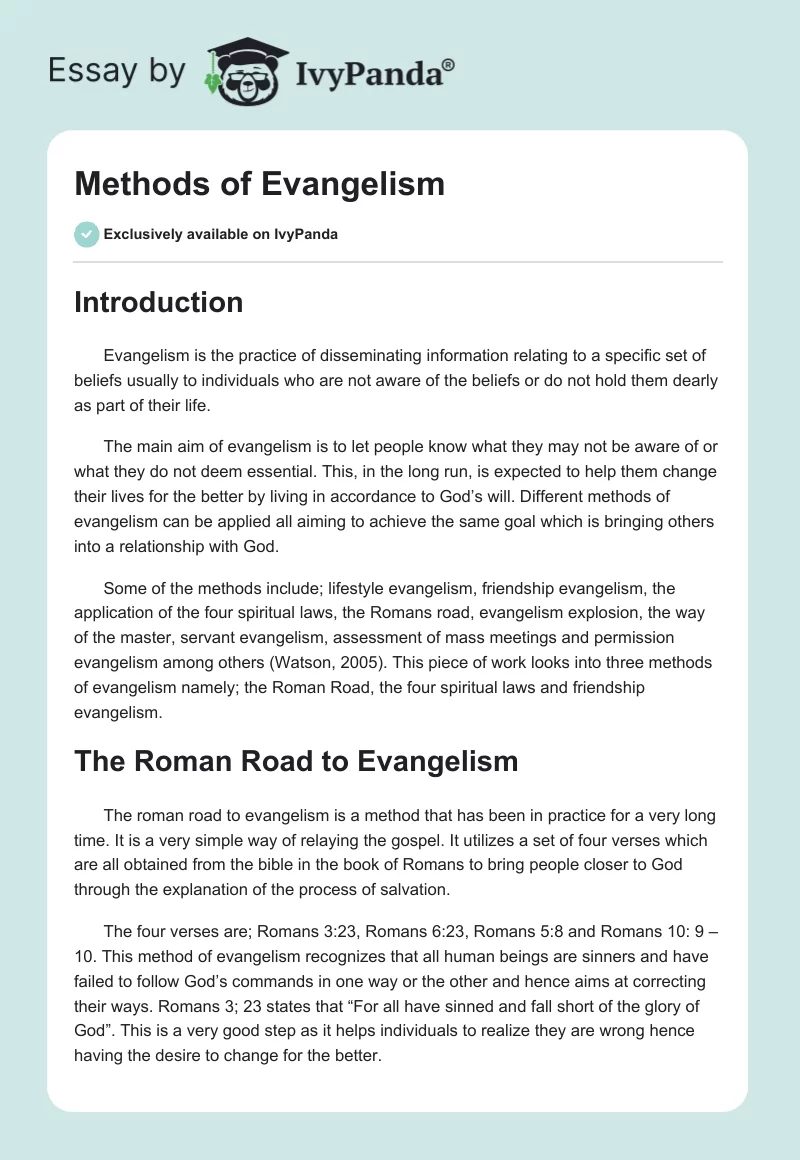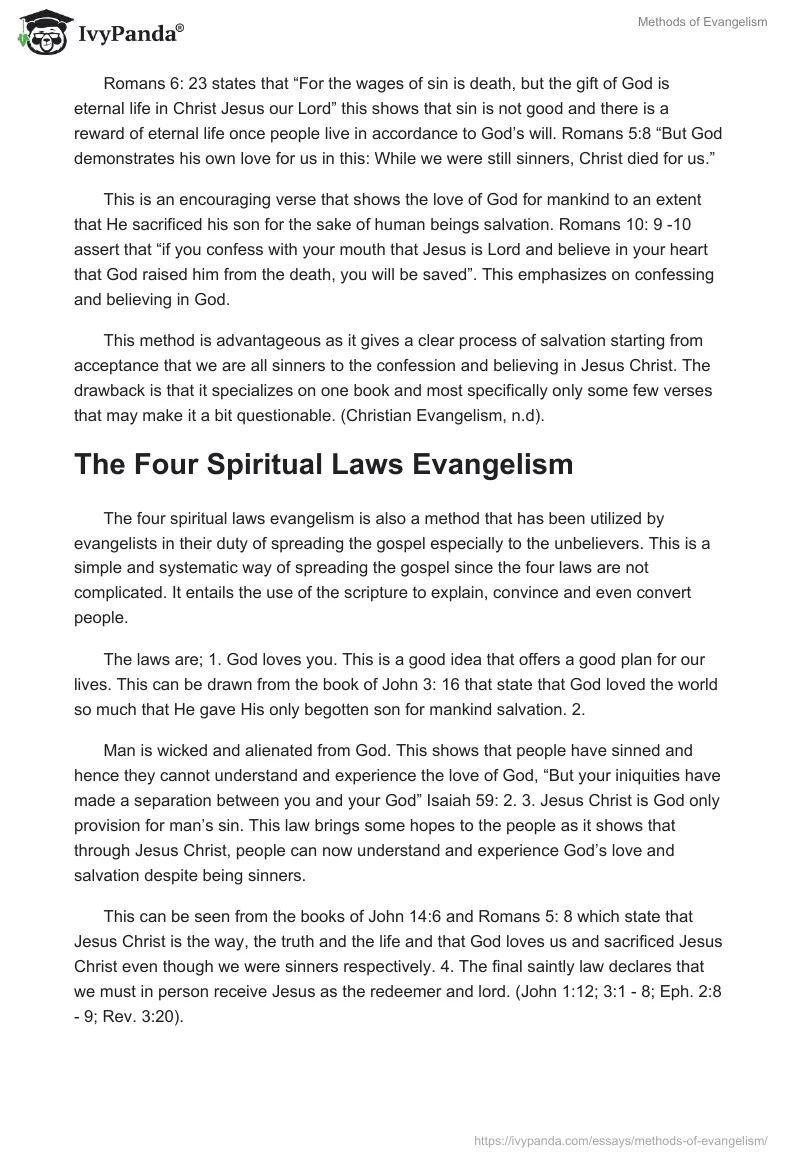Introduction
Evangelism is the practice of disseminating information relating to a specific set of beliefs usually to individuals who are not aware of the beliefs or do not hold them dearly as part of their life.
The main aim of evangelism is to let people know what they may not be aware of or what they do not deem essential. This, in the long run, is expected to help them change their lives for the better by living in accordance to God’s will. Different methods of evangelism can be applied all aiming to achieve the same goal which is bringing others into a relationship with God.
Some of the methods include; lifestyle evangelism, friendship evangelism, the application of the four spiritual laws, the Romans road, evangelism explosion, the way of the master, servant evangelism, assessment of mass meetings and permission evangelism among others (Watson, 2005). This piece of work looks into three methods of evangelism namely; the Roman Road, the four spiritual laws and friendship evangelism.
The Roman Road to Evangelism
The roman road to evangelism is a method that has been in practice for a very long time. It is a very simple way of relaying the gospel. It utilizes a set of four verses which are all obtained from the bible in the book of Romans to bring people closer to God through the explanation of the process of salvation.
The four verses are; Romans 3:23, Romans 6:23, Romans 5:8 and Romans 10: 9 – 10. This method of evangelism recognizes that all human beings are sinners and have failed to follow God’s commands in one way or the other and hence aims at correcting their ways. Romans 3; 23 states that “For all have sinned and fall short of the glory of God”. This is a very good step as it helps individuals to realize they are wrong hence having the desire to change for the better.
Romans 6: 23 states that “For the wages of sin is death, but the gift of God is eternal life in Christ Jesus our Lord” this shows that sin is not good and there is a reward of eternal life once people live in accordance to God’s will. Romans 5:8 “But God demonstrates his own love for us in this: While we were still sinners, Christ died for us.”
This is an encouraging verse that shows the love of God for mankind to an extent that He sacrificed his son for the sake of human beings salvation. Romans 10: 9 -10 assert that “if you confess with your mouth that Jesus is Lord and believe in your heart that God raised him from the death, you will be saved”. This emphasizes on confessing and believing in God.
This method is advantageous as it gives a clear process of salvation starting from acceptance that we are all sinners to the confession and believing in Jesus Christ. The drawback is that it specializes on one book and most specifically only some few verses that may make it a bit questionable. (Christian Evangelism, n.d).
The Four Spiritual Laws Evangelism
The four spiritual laws evangelism is also a method that has been utilized by evangelists in their duty of spreading the gospel especially to the unbelievers. This is a simple and systematic way of spreading the gospel since the four laws are not complicated. It entails the use of the scripture to explain, convince and even convert people.
The laws are; 1. God loves you. This is a good idea that offers a good plan for our lives. This can be drawn from the book of John 3: 16 that state that God loved the world so much that He gave His only begotten son for mankind salvation. 2.
Man is wicked and alienated from God. This shows that people have sinned and hence they cannot understand and experience the love of God, “But your iniquities have made a separation between you and your God” Isaiah 59: 2. 3. Jesus Christ is God only provision for man’s sin. This law brings some hopes to the people as it shows that through Jesus Christ, people can now understand and experience God’s love and salvation despite being sinners.
This can be seen from the books of John 14:6 and Romans 5: 8 which state that Jesus Christ is the way, the truth and the life and that God loves us and sacrificed Jesus Christ even though we were sinners respectively. 4. The final saintly law declares that we must in person receive Jesus as the redeemer and lord. (John 1:12; 3:1 – 8; Eph. 2:8 – 9; Rev. 3:20).
Its through adhering to this last law that we can fully understand God’s manifestation in us and the plans He has in regard to our lives. “But as many as received Him, to them He gave the right to become children of God, even to those who believe in His name” (Slick, 1995).
Friendship evangelism
This is a friendly form of evangelism where some friendship ties are established to enhance the spread of the gospel among the unbelievers. It is, however, a method that can be viewed differently where some take it as a method that one first becomes a friend to the non believers then share the gospel with them.
It has also been viewed as a way in which the evangelists live a righteous life that may attract the non believers and in their attempt to know why they do so, the gospel is relayed to them. The other view is that friendship evangelism entails living a good life and being an example to the others without necessarily preaching the gospel.
However, this method entails preaching the gospel in a friendly manner for it is only through the gospel that people can receive salvation as stated in Romans 10: 14 – 17. Friendship evangelism entails personal relationship of the evangelists with God which is then brought out to the other people. It also involves caring for people to an extent that you want to lead them to salvation through the gospel (McGee, 1990).
Personal Application
The evangelism method that best suits me is the friendship evangelism. This is because I consider it to be the simplest since even though the dissemination of the gospel is required, the atmosphere established between the evangelist and the non believers is enough to enhance change among the people.
The friendship method of evangelism also does not follow strict stipulated rules but rather tries to show the non believers of the importance of change and believing in God from different views and verses from the bible.
The aspect of being friendly and approachable also enhances the spread of the gospel as people will always desire to live a wonderful life and with this in mind they will attempt to discover the reasons behind living a righteous life.
They will, therefore, seek God’s salvation since from deep within them; they can understand the benefits of being believers as opposed to being non believers. Trust and respect are also reinforced between the evangelists and the people through friendship.
Reference List
Christian Evangelism. (n.d). Romans Road. Web.
McGee, M. (1990). Friendship Evangelism! Web.
Slick, M. (1995). The Four Spiritual Laws. Web.
Watson, H.F. (2005).Evangelism. New York: Kessinger Publishing.


